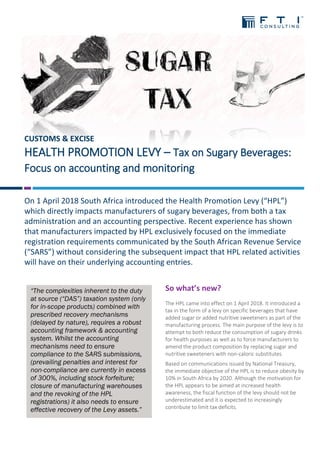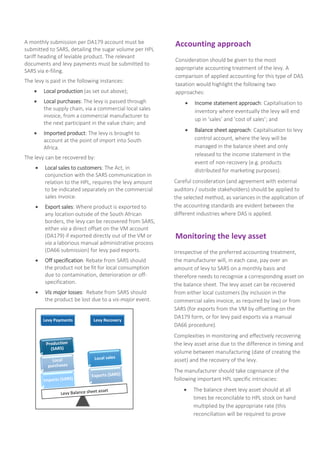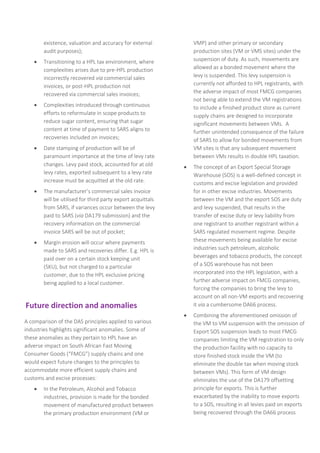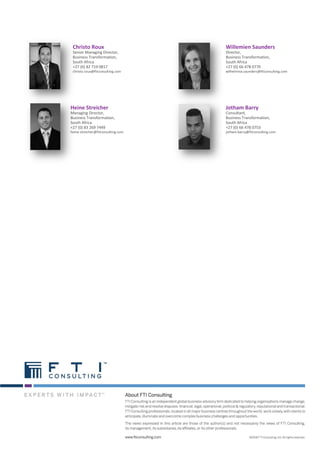Health promotion levy tax on sugary beverages
- 1. CUSTOMS & EXCISE HEALTH PROMOTION LEVY ŌĆō Tax on Sugary Beverages: Focus on accounting and monitoring On 1 April 2018 South Africa introduced the Health Promotion Levy (ŌĆ£HPLŌĆØ) which directly impacts manufacturers of sugary beverages, from both a tax administration and an accounting perspective. Recent experience has shown that manufacturers impacted by HPL exclusively focused on the immediate registration requirements communicated by the South African Revenue Service (ŌĆ£SARSŌĆØ) without considering the subsequent impact that HPL related activities will have on their underlying accounting entries. So whatŌĆÖs new? The HPL came into effect on 1 April 2018. It introduced a tax in the form of a levy on specific beverages that have added sugar or added nutritive sweeteners as part of the manufacturing process. The main purpose of the levy is to attempt to both reduce the consumption of sugary drinks for health purposes as well as to force manufacturers to amend the product composition by replacing sugar and nutritive sweeteners with non-caloric substitutes. Based on communications issued by National Treasury, the immediate objective of the HPL is to reduce obesity by 10% in South Africa by 2020. Although the motivation for the HPL appears to be aimed at increased health awareness, the fiscal function of the levy should not be underestimated and it is expected to increasingly contribute to limit tax deficits. ŌĆ£The complexities inherent to the duty at source (ŌĆ£DASŌĆØ) taxation system (only for in-scope products) combined with prescribed recovery mechanisms (delayed by nature), requires a robust accounting framework & accounting system. Whilst the accounting mechanisms need to ensure compliance to the SARS submissions, (prevailing penalties and interest for non-compliance are currently in excess of 300%, including stock forfeiture; closure of manufacturing warehouses and the revoking of the HPL registrations) it also needs to ensure effective recovery of the Levy assets.ŌĆØ
- 2. Determination of the most effective trigger point in the supply chain at which the product is deemed as being ŌĆśremoved for local consumptionŌĆÖ is critical. The legislation contains an offsetting principle where the levy on exported product can be offset from the monthly payment to SARS. Failing to take advantage of this principle will have a significant negative impact on working capital employed and an increased administrative burden. Similar HPLŌĆÖs have been successfully introduced in other countries such as Mexico and various federal states in the United States of America, with the United Kingdom following suit in 2018. The HPL legislation was included in Schedule 1 Part 7 of the Customs and Excise Act 91 of 1964 (ŌĆ£the ActŌĆØ) and the principles governing the HPL are provided for in the Act and the Rules thereto. HPL is collected under a duty at source (ŌĆ£DASŌĆØ) regime and is therefore a manufacturing tax, as opposed to a transactional tax (e.g. Value Added Tax). In brief, DAS entails that the HPL is collected at ŌĆ£point of sourceŌĆØ and not ŌĆ£point of saleŌĆØ, thus within the manufacturing environment. The liability for HPL generally arises at the point where the product is manufactured and attains the essential characteristics of the listed HPL products i.e. the ŌĆ£essential characterŌĆØ of e.g. a sugary beverage, such as a soft drink. At this point, SARS will generally have an interest in the product. The HPL legislation specifically excludes alcoholic beverages, 100% fruit juices and unsweetened beverages with a dairy base, but it includes sweetened waters, syrups (to be diluted prior to consumption), powder-based drinks (including those with a cocoa basis and to be mixed with a fluid before consumption) and sweetened fruit juices. Concentrates and products that require dilution or powder to be mixed with a fluid will result in the HPL being calculated on the sugar content of the final product i.e. post dilution ratio in line with the prescribed dilution criteria. It is important to note that the sugars subject to the levy include both added and intrinsic sugars; a sweetened fruit juice will therefore not only be levied on the added sugar but also on the sugar contained naturally within the fruit juice base. Given the complexity of the composition of most products subject to HPL, it is essential to obtain customs tariff determinations from SARS on those products where a level of uncertainty governs the decision to include or exclude such products from HPL items provided for in the Act. Examples of the latter includes various sweetened dairy products such as drinking snacks, milk based fruit drinks, energy drinks, carbonated fruit juices (100% or mixed) and HPL products with a sugar content of less than 4g/100ml . Impact on operations Any person/organisation who manufactures sugary beverages is obliged to determine if it is regarded as a non-commercial or a commercial manufacturer, with reference to their annual consumption of sugar added to HPL products during the manufacturing process. Commercial manufacturers (i.e. manufactures of sugary beverages with a sugar consumption exceeding 500 kilogram per calendar year) must license their manufacturing premises with SARS as a customs and excise manufacturing warehouse (ŌĆ£VMŌĆØ) which will be subject to the provisions of the Act and permissible business processes as legislatively prescribed. The levy is currently recovered at 2.1 cents per gram of sugar per 100 ml of the sugary beverage. The first 4 grams of sugar per 100 ml is levy free. For calculation purposes, the HPL legislation requires that the sugar content of each product be confirmed by a SANAS / ILAC certified laboratory. However, subject to the scope and nature of the products manufactured, these laboratory results could substantially differ on the same product, resulting in the need for the recording thereof within a clearly defined governance protocol to ensure reputational risks are limited should non-compliance to the Act be alleged in future SARS audits. To address the latter, it is advised that an application for the tariff determinations of HPL products includes the relevant laboratory results to ensure that SARS agree to the correctness thereof.
- 3. Levy Payments Levy Recovery A monthly submission per DA179 account must be submitted to SARS, detailing the sugar volume per HPL tariff heading of leviable product. The relevant documents and levy payments must be submitted to SARS via e-filing. The levy is paid in the following instances: ’éĘ Local production (as set out above); ’éĘ Local purchases: The levy is passed through the supply chain, via a commercial local sales invoice, from a commercial manufacturer to the next participant in the value chain; and ’éĘ Imported product: The levy is brought to account at the point of import into South Africa. The levy can be recovered by: ’éĘ Local sales to customers: The Act, in conjunction with the SARS communication in relation to the HPL, requires the levy amount to be indicated separately on the commercial sales invoice. ’éĘ Export sales: Where product is exported to any location outside of the South African borders, the levy can be recovered from SARS, either via a direct offset on the VM account (DA179) if exported directly out of the VM or via a laborious manual administrative process (DA66 submission) for levy paid exports. ’éĘ Off specification: Rebate from SARS should the product not be fit for local consumption due to contamination, deterioration or off- specification. ’éĘ Vis major losses: Rebate from SARS should the product be lost due to a vis-major event. Accounting approach Consideration should be given to the most appropriate accounting treatment of the levy. A comparison of applied accounting for this type of DAS taxation would highlight the following two approaches: ’éĘ Income statement approach: Capitalisation to inventory where eventually the levy will end up in ŌĆśsalesŌĆÖ and ŌĆścost of salesŌĆÖ; and ’éĘ Balance sheet approach: Capitalisation to levy control account, where the levy will be managed in the balance sheet and only released to the income statement in the event of non-recovery (e.g. products distributed for marketing purposes). Careful consideration (and agreement with external auditors / outside stakeholders) should be applied to the selected method, as variances in the application of the accounting standards are evident between the different industries where DAS is applied. Monitoring the levy asset Irrespective of the preferred accounting treatment, the manufacturer will, in each case, pay over an amount of levy to SARS on a monthly basis and therefore needs to recognise a corresponding asset on the balance sheet. The levy asset can be recovered from either local customers (by inclusion in the commercial sales invoice, as required by law) or from SARS (for exports from the VM by offsetting on the DA179 form, or for levy paid exports via a manual DA66 procedure). Complexities in monitoring and effectively recovering the levy asset arise due to the difference in timing and volume between manufacturing (date of creating the asset) and the recovery of the levy. The manufacturer should take cognisance of the following important HPL specific intricacies: ’éĘ The balance sheet levy asset should at all times be reconcilable to HPL stock on hand multiplied by the appropriate rate (this reconciliation will be required to prove
- 4. existence, valuation and accuracy for external audit purposes); ’éĘ Transitioning to a HPL tax environment, where complexities arises due to pre-HPL production incorrectly recovered via commercial sales invoices, or post-HPL production not recovered via commercial sales invoices; ’éĘ Complexities introduced through continuous efforts to reformulate in scope products to reduce sugar content, ensuring that sugar content at time of payment to SARS aligns to recoveries included on invoices; ’éĘ Date stamping of production will be of paramount importance at the time of levy rate changes. Levy paid stock, accounted for at old levy rates, exported subsequent to a levy rate increase must be acquitted at the old rate. ’éĘ The manufacturerŌĆÖs commercial sales invoice will be utilised for third party export acquittals from SARS, if variances occur between the levy paid to SARS (via DA179 submission) and the recovery information on the commercial invoice SARS will be out of pocket; ’éĘ Margin erosion will occur where payments made to SARS and recoveries differ. E.g. HPL is paid over on a certain stock keeping unit (SKU), but not charged to a particular customer, due to the HPL exclusive pricing being applied to a local customer. Future direction and anomalies A comparison of the DAS principles applied to various industries highlights significant anomalies. Some of these anomalies as they pertain to HPL have an adverse impact on South African Fast Moving Consumer Goods (ŌĆ£FMCGŌĆØ) supply chains and one would expect future changes to the principles to accommodate more efficient supply chains and customs and excise processes: ’éĘ In the Petroleum, Alcohol and Tobacco industries, provision is made for the bonded movement of manufactured product between the primary production environment (VM or VMP) and other primary or secondary production sites (VM or VMS sites) under the suspension of duty. As such, movements are allowed as a bonded movement where the levy is suspended. This levy suspension is currently not afforded to HPL registrants, with the adverse impact of most FMCG companies not being able to extend the VM registrations to include a finished product store as current supply chains are designed to incorporate significant movements between VMs. A further unintended consequence of the failure of SARS to allow for bonded movements from VM sites is that any subsequent movement between VMs results in double HPL taxation. ’éĘ The concept of an Export Special Storage Warehouse (SOS) is a well-defined concept in customs and excise legislation and provided for in other excise industries. Movements between the VM and the export SOS are duty and levy suspended, that results in the transfer of excise duty or levy liability from one registrant to another registrant within a SARS regulated movement regime. Despite these movements being available for excise industries such petroleum, alcoholic beverages and tobacco products, the concept of a SOS warehouse has not been incorporated into the HPL legislation, with a further adverse impact on FMCG companies, forcing the companies to bring the levy to account on all non-VM exports and recovering it via a cumbersome DA66 process. ’éĘ Combining the aforementioned omission of the VM to VM suspension with the omission of Export SOS suspension leads to most FMCG companies limiting the VM registration to only the production facility with no capacity to store finished stock inside the VM (to eliminate the double tax when moving stock between VMs). This form of VM design eliminates the use of the DA179 offsetting principle for exports. This is further exacerbated by the inability to move exports to a SOS, resulting in all levies paid on exports being recovered through the DA66 process
- 5. (which limits recoveries to 5 documents per return). The impact is a significant increase in administrative burden both on SARS and HPL registrants. ’éĘ Current HPL legislation does not provide for ŌĆ£allowable lossesŌĆØ similar to other industries governed by the DAS regime. The HPL legislation rebates will only be allowed for returns to the VM (of origination) due to: Contamination, deterioration and off-spec product. Due to current FMCG supply chain processes, it is common cause that most companies are unable to link the HPL return to the VM of origination and even if possible to do so, it is not commercially feasible to return product to the VM of origination. How can FTI help? FTI provides the most comprehensive HPL service offering in South Africa that includes both a legal and accounting advisory solution. The legal advisory solution includes policy guidance, SARS liaison on all customs tariff and levy related queries, submissions, training and dispute advisory services. The accounting advisory offering revolves around a bespoke industry leading solution that comprises an excise and levy specific FTI proprietary developed software database containing all possible inventory movements provided for under the HPL legislation. ’éĘ The database allows us to import and analyse the clientŌĆÖs actual historical supply chain movements, providing real data to support decision making for the most efficient VM registration applicable to the clientŌĆÖs supply chain (business case based on actual impact of registration to the income statement and working capital requirements); ’éĘ Based on knowledge of administering DAS in various industries we developed a leading two tiered accounting reconciliation methodology with the following attributes: o Monthly reconciliation of the HPL balance sheet asset to the total inventory asset (as required for external audit purposes) o Detailed monthly matching of every inventory movement and the corresponding HPL impact to all levy payments (local purchases, DA179 SARS payments, Imports) and all levy recoveries (local commercial sales invoices, export acquittals via DA179 offsets and DA66 refunds). The reconciliation methodology allows us to assist clients by designing the most appropriate chart of accounts; or provide an outsourced managed services solution where we supply accounting journals; provide DA179/66 information; perform monthly levy reporting packs (including linking levy to closing inventory and detailed matching). Once FTI is satisfied that the levy legislation, together with the clientŌĆÖs supply chain has stabilised (indicated by limited number of monthly unreconciled entries), a Business Requirement Specification (BRS) is produced guiding the client to code their in-house ERP system to effectively manage the HPL processes.
- 6. Christo Roux Senior Managing Director, Business Transformation, South Africa +27 (0) 82 719 0817 christo.roux@fticonsulting.com Heine Streicher Managing Director, Business Transformation, South Africa +27 (0) 83 269 7449 heine.streicher@fticonsulting.com Willemien Saunders Director, Business Transformation, South Africa +27 (0) 66 478 0770 wilhelmina.saunders@fticonsulting.com Jotham Barry Consultant, Business Transformation, South Africa +27 (0) 66 478 0753 jotham.barry@fticonsulting.com






